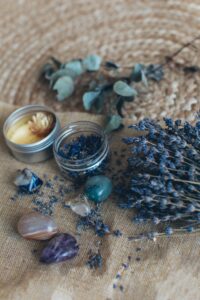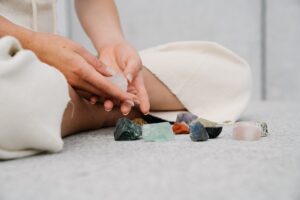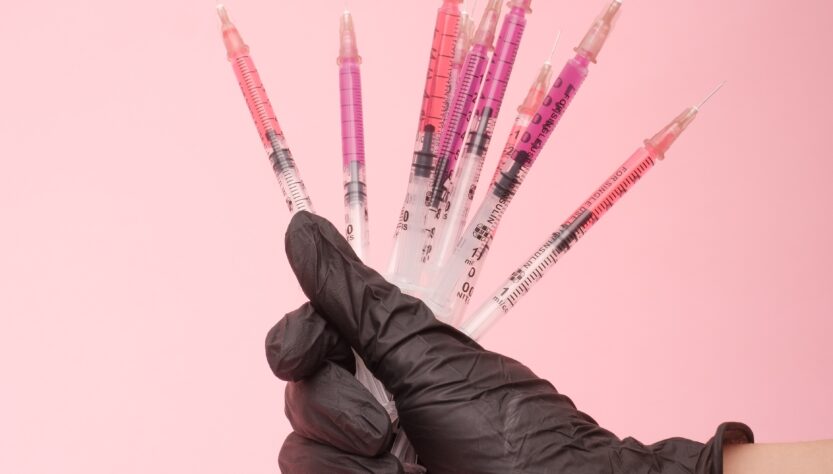Dr. Ahmed Ibrahim
Ph.D. Molecular Pharmacology,
TIU – Erbil
Humans’ eternal fascination with colors led them to consider them a source not only of magic, beauty, and sacredness, but also of physical healing and spiritual upliftment. Primitive man took from the sun yellow, red, and green bases for activity, vitality, and toil at work, and from the tan of the night he took purple, blue, and indigo as deceivers for habitation and relaxation. And it reached us today with a modern version that found a place for itself within all the fields surrounding us, whether we are aware of it or not.
Colors have a direct and magical effect on human health and life, so the best thing you can offer to one of your sick friends is a bouquet of flowers in different colors that will help him to be active again and ward off exhaustion and boredom.
In nature, the multiplicity of colors of stones and the mixing of one with the other is a beauty that dazzles the eye, just as the colors of the coral reefs at the bottom of the Red Sea astonish it. And the Holy Qur’an mentions the phrase “their different colours” after God Almighty said “white and red”, and this was an indication that the two primary colors are white and red. And in the cattle, from the multiplicity of the cattle’s skins, that beauty is achieved, which was referred to by that noble verse, Surat Al-Nahl, verse (6), and you have beauty in it when you rest and when you leave.
Color is radiant energy with a specific wavelength that the photoreceptors in the retina translate into colors. The retina contains three colors: green, red, and blue, and the rest of the colors consist of mixing these three colors. When the light energy enters the body, it stimulates the pituitary gland and the pineal body, which leads to the secretion of certain hormones that occur in a group of physiological processes, and thus direct control of our thinking, mood and behavior.
Colors have a direct effect on cells and their growth. Each color of the spectrum has a positive effect on a specific organ in the human body. And every deficiency in the saturation of a certain color can lead to diseases and severe health impairment. For example, there are colors that make you feel happy, psychologically and physically comfortable, and vice versa with regard to other colors that may make you sad, bored and depressed. Therefore, the human body needs saturation with these colors, such as its need for water, air and food.
It is strange that colors have an effect on the blind, just like the sighted, as a result of the energy frequencies that are generated within their bodies, and this idea was used by the ancient Chinese in the treatment of diseases, and it is called Feng Shui. The pharaohs also used the color above green inside the pyramids to resist germs and kill bacteria, thus preserving mummies.
Long through history, people believed that since disease comes from nature in some mysterious way, things from nature, with colors in it, were necessary to be used to combat it. What we would consider today as just a piece of jewelry was most likely an amulet of protection, in addition to being an ornamental piece. The evil eye could be diverted and prevented by some turquoise stones, blue beads, red or black paint on the forehead, a red ribbon, or a piece of coral. In the markets of Cairo in Egypt it is customary to sell blue earthenware beads, with a bright blue surface, and wholly half an inch in diameter, to caravansary, which make collars of them and tie them on the foreheads of camels or horses before setting out on their journeys. The inhabitants of this country believed that the harmful looks of the envious eye could be diverted to these beads and kept away from animals. It is fairly certain that the brass rounds and other ornaments that adorned the bridles of cart and draft horses, such as the large brass trumpets hanging from their collars, were originally intended to protect the animal from the evil eye, but this fact has been forgotten, and amulets have become mere accessories.
Among the historical literature on some areas of the global coniferous forests in the regions of Eastern Europe, Russia and India, as well as in the regions of Iraqi Kurdistan, treatment by methods centered around gems was mentioned; It was amber (gray amber), a fossilized resin from extinct coniferous trees. It was used to treat earache and eye diseases. Amber beads were used to treat fever, rheumatism, toothache and headache. The amethyst was used to treat gout, and it is a violet gemstone that is composed of pink and cyan red, and it includes several types of violet quartz, which is often used in the jewelry industry. It was believed in Europe that this stone protects the wearer or owner from drunkenness or excessive drinking. In the ancient Greek civilization and in ancient Rome, people wore an amethyst stone and made drinking glasses out of it, in the belief that this stone would prevent poisoning.
The red agate used for clogged the bleeding, and the ancient Yemenis used it in folk remedies. The Yemeni agate, for example, is still used to treat migraines, headaches, and nervous spasms. White agate was used to break up stones, emeralds were used to treat eye diseases, and al-Bajadi granite was used to treat skin rashes. As for the jade stone, it was used to treat dropsy, and it was useful in facilitating childbirth. It is widely used in China, where icons, amulets and ornaments made from it are considered to bring luck and happiness. Myanmar is the main region in the world for the extraction of jade of the type jadeite, followed by Guatemala in Latin America.
The ancients’ people believed that lapis lazuli has medicinal properties, and it is a blue metal used for decoration, so they used to crush the stone and mix it with milk, and the mixture was used as a coating for pimples and ulcers. The black amber stone was used to treat epilepsy, and the sapphire dipped in water was used as a medicine for the stomach. The supreme sapphire dig out and can be find in Myanmar “Burma”, it was described as similar to the blood of a pigeon.
The American scientist Edwin de Babbitt wrote one of the masterpieces of the book ((Principles of Light and Color)). He created a world revolution, albeit a limited one, in the art of color therapy. Babbitt was born in Hamden, New York city, on the 1st of February 1828. His book was published in 1878; Babbitt became an instant celebrity, and soon became president of the New York College of Magnets.
Babbitt made a wonderful series of relationships between colors and the elements, and between the elements and the colours, describing these as thermal colors and electric colours. Let us quote what he said: “There is a series of three gradations in the strange abilities of colours, the center and peak of the electrical effect which calms the nerves in the color violet, the peak of the electrical effect which calms the vascular system in the color blue, the peak of brightness in the color yellow, and the peak of hotness or heat It is located in red.
This is not an imaginary division of adjectives, but a real division. The color red, which resembles a flame, implies the principle of warmth in itself, and blue and violet imply the principle of coldness and electricity. Thus, we have many methods of color influence, including color gradations, light and shade gradations, smoothness and roughness gradations, electrical power gradations, optical power gradations, and thermal power.
To this day, a hundred years after Babbitt’s time, the color therapy he founded is still in practice, and books based on his principles are still being published.


There are courses, lectures, meetings, and color schools, all of which belong to Babbitt. Although its equipment, devices, and prescriptions cannot be legally manufactured or applied in the United States, chromo-therapy is still a living ‘science’ in England. There is a global trend towards supporting alternative medicine, and subjecting it to scientific study and research.
Color and Green Light Therapy
Color therapy has become a method of psychological and physical therapy, as the science of color therapy aims to combat disease by restoring the natural balance between the color energies in the body and building the ethereal body by applying the correct color vibrations to the centers that are then able to energize the physical body.
After the success of many experiments in treating premature babies using the blue color, and discovering the effect of colors on blood pressure and activity rates of vital organs, the latest scientific experiments have proven the ability of superior colors in treating many organic and psychological diseases, and recent studies have confirmed that colors nourish the soul and body and relax the nerves. The human body is necessarily associated with nature in all its various forms.
Scientists have discovered the existence of an electromagnetic field around every living organism, which absorbs light and analyzes it into the colors of the spectrum that start with red and end with violet. It was also found that the various tissues of the body receive their needs from the energy of this spectrum, which leads to their health and enhances their ability to perform their biological functions. This means that there is a biological need for the tissues of colors, and if they are absent or decreased, this tissue will be exposed to weakness, disease and disorder. These facts have been used therapeutically, so it is now possible to give the patient a dose of color as a dose of medicine or food is given, as it has become part of radiotherapy.
By December 2022, a recent study published in the Science Translation Medicine journal, using green light can be a safe and economical way to relieve pain. The researchers elaborated on the biological basis of how it affects pain relief.
According to a report published by the Science Alert website, scientists have worked to discover the effect of green light on relieving pain for at least half a decade, and many researchers have already studied this effect before, but the new study on rodents, which he led Neuroscientist Yulong Tang of Fudan University in Shanghai, China, has revealed eye cells and brain pathways that support the reduction of pain that an individual sometimes feels after exposure to low-intensity green light.
In a series of experiments, the researchers discovered that the cones and rods, the eye cells that sense light, reduced pain from green light in healthy mice and mice with arthritis. As scientists often do, the researchers disabled specific cells to see what effect this had on the animals’ sense of pain. And when the rod cells were disrupted in some mice, those animals showed partial relief, while mice without cone photoreceptors showed no signs of pain relief at all when exposed to green light.
The research team explains in their published research that they found the cone photoreceptors in the retina are essential for green light accommodation, while the rod cells play a secondary role. From there, they followed the path electrical signals take from the eyes through the brain. After being flooded with green light, the cone photoreceptors and rod cells stimulated a group of brain cells previously associated with the sedating effects of bright light in general. In this part of the brain, these neurons project a hormone involved in pain signals. These cells then relay the message to another part of the brain called the dorsal raphe nucleus that modulates pain, effectively reducing pressure on intense pain. This study succeeded in identifying pain circuits in the mammalian brain that respond to visual input and expanded our understanding for a safe and easy way to put it down.
Although it is not clear whether color perception is comparable between humans and rodents, exposure to green light in both humans and rodents reduces pain sensitivity, suggesting shared mechanisms between the two species.
According to the “Science Alert” website report, recent clinical trials also reported that a few hours of green light therapy each day reduced the intensity of pain in a small group of fibromyalgia patients and the number of headache days in migraine patients. The green light could benefit patients with chronic low back pain after surgery, reducing their reliance on painkillers.
Therapists use a wide range of different methods to treat their patients, including covering them with colored scarves, shining colored lights on different parts of their bodies, showing them certain colors, massaging them with colored oils, or adding different colored clothes to the wardrobe.
This therapeutic technique, developed by American neuroscientists, relies on narrow beams of colored light used to activate the photoreceptor cells known as rods and cones located behind the eye in several sessions of 20 minutes each, with the aim of rebalancing the autonomic nervous system.
Therapists believe that this technique, if it does not treat pathological conditions, will help improve the patient’s mental health in general. For example, it can reduce cases of autism and aggression in children. It also helps achieve psychological support and comfort for cancer patients and improve their quality of life.
Experts pointed to the increasing demand of parents to use the colored light boxes, known as Lumatron, to treat their children with medical problems ranging from autism to dyslexia, dyspraxia and discord, after this treatment achieved excellent results in this regard.
Aside from the role of green light in relieving chronic pain, new research findings may explain why spending time in nature is so good and spending time in farms, forests, and other dark green natural places may calm our nervous system in more ways than one.
Sun Light Therapy
Knowing that light and color are therapeutic agents has an early start. The sunbathing is an ancient practice; As the Assyrians, Babylonians, and ancient Egyptians practiced it, and there was a highly developed sect that bathed in the sun and air in ancient Greece and Rome.
With the scientific advancement of medicine, the use of new diagnostic procedures and devices, new chemicals, drugs and antibiotics, the ancient art of heliotherapy has become obsolete. In the nineteenth century, a modern pioneer appeared on the scene. Where he introduced light therapy in a new beginning. Dane Nils R Vinsen found magical benefits in light. In his early years, he sought to treat smallpox using visible red light to prevent scar tissue. Around 1896, he noticed the radioactive properties of sunlight and founded the Institute of Light for the Treatment of Tuberculosis, for which he was awarded the Nobel Prize in 1903. Sunlight became the main treatment for tuberculosis, and sanatoriums around the world were designed with an architectural style of courtyards, lobbies, and sun-drenched roofs.

In modern medicine, there is a belief that sunlight, including the speed of the “colors of the spectrum,” has the ability to produce vitamin D under the skin. This vitamin is reduced in the case of osteomalacia, which is one of the most important philosophies in bone formation.
There is no doubt that some amount of ultraviolet light is needed in industrial settings, and light sources that radiate this light are currently being manufactured. Russians have over the years used ultraviolet light, in addition to traditional fluorescent light, in schools, hospitals, and offices. In school, children grew faster than usual, improved work ability and grades, and had fewer colds (inflammation of the respiratory tract). Russian miners are also required to have UV treatments. So what happens? According to a report by the International Commission on Illumination, “The effect of ultraviolet radiation enhances enzymatic processes of metabolism, increases the activity of the endocrine system, enhances the body’s biological immune response, and improves the tone of the central nervous and muscular system.
It is worth to mention that that if UV rays can tan the skin and cause dermatitis, visible light can also have effects. For example, it is a curious fact that exposure to “visible” light can help treat damage caused by invisible “ultraviolet” light.
And in a rare disease known as “solar urticaria,” some unlucky people may develop a rash when exposed to “visible” blue or violet light. The reason been explained by the scantest Harold F. Bloom, “It is fine to say that this response occurs in normal skin, unlike in this case. Due to the presence of a photoactive substance that absorbs the blue and violet regions of the spectrum”.
The skin rash, which occurs when exposed to sunlight, may follow the use of cosmetics, perfumes and aftershave lotions, and may also follow eating strawberry cake or buckwheat cake. Workers have been known to develop rashes after exposure to certain industrial fumes, carrying wild carrots or figs, and coal tar products. Some animals may suffer fatal “burns” from sunlight after eating certain plants such as Saint John.
Choose the colors around you carefully
After you have reached the locomotive of historical colors that combined science, art, and medicine, do not hesitate to go up to it. It is time to shake off the randomness from the walls of your home, choose colors that serve your mood, your family, and your lifestyle, and create harmonious and comfortable spaces that play the role for which they were created. But first you have to grasp the meaning of each color separately, and delve into the correct uses of it.
Red
Whenever red is mentioned, emotions and enthusiasm are mentioned, and it is known that this color raises blood pressure and heart rate, and in the psychology of colors it is an important source of energy, so its presence is important in the spaces that you have chosen to receive your guests. Red will add enthusiasm and joy to the discussions and dialogues that you engage in. In the presence of this warm color. You can also choose it to leave a good impression on your visitors and make them feel comfortable and safe, and it will certainly be the most appropriate option for painting the walls of the room that was chosen to be the dining room, as red is characterized by its wide reputation regarding the ability to open the appetite for food and pass the feeling of enthusiasm and pleasure while eating, and share it.
Yellow
If you are looking for a bright, clear and warm color, you will definitely find what you need in yellow. Yellow gives a feeling of warmth and intimacy to small spaces and entrances, and it can be a good choice for your kitchen walls because it stimulates the metabolism and provides you with a space to start actively every morning. But yellow has two sides, as it can become the opposite of everything mentioned if you are not careful in using it. Studies show that people are more likely to lose their temper and feel angry in spaces that are predominantly yellow, and some can find it visually harmful if not Luck ally them to choose the right shade, so you should be careful as you enter this color into your home.
Green
Green in its many shades can affect your home in different ways. The combination of refreshing blue and warm yellow with green makes this color a suitable color for almost any room in your home. Green promotes a sense of comfort and calm, relieves depression and relaxes the nerves, and always carries a sense of peace, relaxation, stability and balance, and in addition to all this green encourages creativity and achievement.
You can resort to calm tones to create spaces that provide you with peace and comfort and relax your nerves and eyes. These specifications make green the right color for your bedroom walls, where you can relax and be stripped of the disturbances that meet you outside. You can also use it in the salon to enhance a sense of harmony and comfort, or in the kitchen to infuse feeling. With freshness and vitality, and obtaining a modern and bright kitchen, but it is necessary to be careful to use calm and dim tones and to stay away from dark tones so as not to make you tense or awaken a feeling of discomfort.
Blue
Blue usually reminds us of the sky and the sea, and is associated with calm, spaciousness and freedom. The blue color positively affects the human mind and body, helps to feel comfortable, stimulates the brain to produce chemicals that bring calm and tranquility, and helps create balance and creativity. It is recommended to adopt blue in children’s rooms, because it helps them sleep peacefully and spend good nights, and it is also a great choice for people who suffer from insomnia or people who tend to spend a lot of time in meditation
But although blue is known for its ability to give comfort, its dark tones can move you from a positive experience to the complete opposite. Dark blue, if used improperly, stimulates feelings of depression, sadness, and lethargy.
If you want to adopt blue as a main color in an entire room, it is preferable to use its bright and soft shades, such as turquoise or sky blue. Stay away from violet blues, as they can make a room look cold and uninviting.
Orange
Orange is the title of emotional release, enthusiasm, and positivity. If you want to create a warm and lively space, raise your productivity, and boost your self-confidence, it is preferable to make orange its color. It is a vibrant and stimulating color that will inspire you, increase your creative ideas, and push you to challenge and learn more about yourself.
Orange also activates the social side in us, pushes people to free themselves from the restrictions that shackle them, and strengthens social bonds. So it will be a great choice for the living room. But if you are on a diet, its presence in the folds of your kitchen will be a curse because it opens the appetite and pushes you to eat.
After you know how colors can affect your mood, make sure that the next time you are on the verge of moving to a new house or when you intend to repaint the walls of your house or change the furniture, that the journey of choosing colors be a deliberate journey far from randomness, because choosing the wrong color may mean living In a broken mood.


